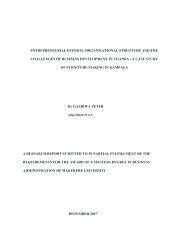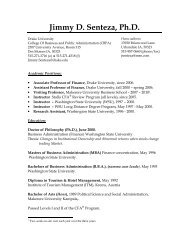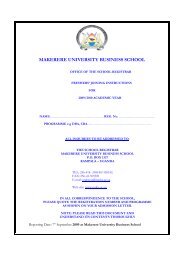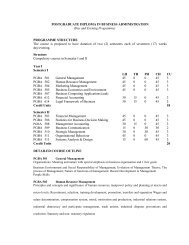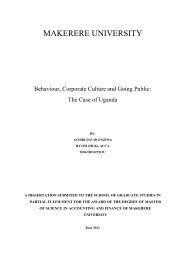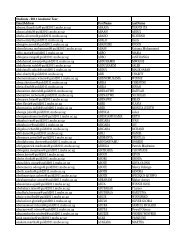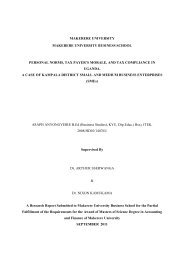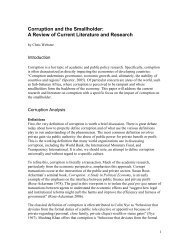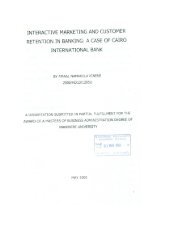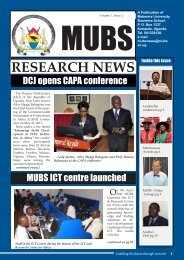13th Annual International Management Conference Proceeding
13th Annual International Management Conference Proceeding
13th Annual International Management Conference Proceeding
You also want an ePaper? Increase the reach of your titles
YUMPU automatically turns print PDFs into web optimized ePapers that Google loves.
Land<br />
Land size and land fragmentation<br />
This was found to be the major problem affecting agricultural output. The average household size was 7<br />
persons while the average land holding is 2.5 acres of land per household according to 2002 National<br />
Housing and Population census. The findings of the study however indicated that all households interviewed<br />
own at least some pieces of land. The vital question was the size and quality of land. Out of the 200<br />
respondents, 163 reported that the size of land was not enough for increased production. Because of limited<br />
size of land, most farmers cannot enjoy the scale economies of production.<br />
The problem of land size has been aggravated by land fragmentation. This refers to a situation where land<br />
has been divided and sub – divided into smaller prices owing to the independence of married sons. The<br />
findings indicate that out of 200 respondents, 152 indicated that they own more than one plots of land<br />
detached from each other. It is this problem of land fragmentation that has limited the mechanical<br />
transformation of agriculture. The problem of land fragmentation was found to be getting worse as families<br />
expand in size. The problem of land size has its roots in the traditional systems of land transfer in which<br />
boys are given parts of land after getting married. It should be noted that efforts to consolidate this land<br />
most often becomes futile since under a traditional setting these fragmented plots of land fall under different<br />
ownership.<br />
Land quality<br />
The problem of land size is aggravated by the quality of this land. A critical issue for small holders in the<br />
Sub County is the shortage of good quality farming land. One hundred and seventy three (173) respondents<br />
indicated that the quality was poor. The quality of land was found to be declining following the expansion<br />
of most families that puts pressure on land. The quality of the farming land is also deteriorating because of<br />
many factors. The traditional practice of cut and burn or shifting cultivation, which enables land to<br />
regenerate, has declined owing to a weak male labour to perform the tasks of land clearing. This has sharply<br />
reduced the capacity of the area to supply food to the neighboring towns.<br />
Land Ownership<br />
Under the traditional settings, land is owned by men who are the heads of households. Although this is<br />
changing, it remains a problem in Nyakyera sub- county since men have to determine the allocation of land<br />
and sometimes men have to rent out some plots of land to get money for drinking.<br />
One hundred and two (102) respondents reported that land is owned by men while 92 said that land is<br />
owned by the whole family members. Four (4) respondents were not sure of who exactly owns their land.<br />
Whereas most women do not own land, it is important to note that they are most active members of the<br />
family in agriculture. Men concentrate on light work such as clearing the bush and building perimeter fenced<br />
around the gardens and looking after the goats. A positive relationship is expected between individual land<br />
rights and productivity. Feeder (1988) hypothesized that increased individualization of rights improves a<br />
farmer’s ability to reap returns from investments on land, resulting in greater demand for land improvements<br />
and complementary inputs.<br />
Labour<br />
The average household size from sample was seven (7) persons but the average number of people involved in<br />
day to day activities in agriculture was three (3). This according to the respondents is attributed to high<br />
number of young people how spend most of their time in trading centers in hat has been termed as assumed<br />
urbanization operating boda- boda but never bring money home. The skills of those who remain in rural<br />
areas are very low<br />
Skills<br />
Most of the respondents rated themselves as semi-skilled due to lack of regular trainings and workshops.<br />
It was further indicated that 172 respondents has not received any training in the last 2 years. Of all those<br />
who had received some raining, 75 % indicated that this training had not increased their output.<br />
Results showed that although there are trainings received by some farmers, there have been little changes in<br />
the output level. Because of this, many are reluctant in attending seminars organized by District farmers’<br />
78



